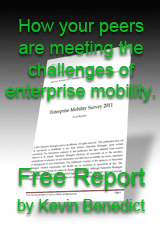I taught mobile strategy workshops in 11 countries last year. In these workshops, one of the first questions I ask is, "What tempo is your business wanting and/or needing to support?" The definition of tempo that I use is "rate of motion or activity." In other words, "Does your business environment require a real-time data and communication environment, near-real-time, or is an hourly or daily tempo sufficient?" These are important questions and they dictate what kind of mobile solution architecture you should be considering.

I helped a large mining company a few years ago to think through their mobile strategy. They operated large underground mines in remote locations. They needed production numbers from the mine to prepare downstream resources to process and transport the mined materials. They needed to know who came to work in remote locations, who was sick, who was on vacation, etc. They needed to know what equipment required repair and maintenance and when that work would impact production. They needed to know the production of each shift.
At the time the mining company contacted me, they were using color coded sheets of dirty paper to collect this data in the mine, and at the end of each shift, the supervisor delivered it to a job shack at the top of the mine and an administrative person would enter the data into a networked software system on a desktop computer.
The mining company wanted to upgrade their processes and communication from once every shift, to a real-time tempo. They wanted instant notification if equipment broke down, and if parts or expert technicians were needed to keep production going. They wanted to know instantly about any safety issues. They wanted to know the production numbers throughout the shift, not just at the end of the shift.
Every business process and industry has an optimal operational and communication "tempo." Knowing what tempo is possible, and how an increased tempo could help improve your operations is critical. Enterprise mobility solutions have the capability of revolutionizing complete industries by increasing their tempo to provide better customer service, respond to issues faster, fix problems before they become bigger, take advantage of opportunities before competitors can respond, and to greatly improve productivity and efficiencies.

Some companies understand the competitive advantages that an increased tempo offers, but others don't. Even today, I have seen companies implementing enterprise mobility solutions and mobile strategies that effectively limit them to a relatively slow tempo for the next three or four years, while their competitors are creating infrastructure and mobile architectures that will enable real-time communications and updates. These companies see value in real-time business analytics, real-time updates, real-time alerts and notifications, real-time GPS tracking, real-time scheduling, real-time CRM data, real-time inventory updates, real-time production information, etc.
What tempo would optimize your business or business process? What will it take to support a faster tempo? Do you have the capability of processing and utilizing real-time mobile data, or would the data be wasted on antiquated back-end systems and and out-data processes?
My recommendation is to understand your current tempo of communication and operations and how an increased tempo could positively impact your business. Identify the bottlenecks in your system that limit your tempo and start removing them. Mobile data sent from smartphones, tablets, mobile handheld computers, M2M, RFID, bar code scanners, GPS, etc, can provide you with real-time data. Your challenge is knowing what to do with it, and how to integrate and process it to improve your competitive position.
*************************************************************
Kevin Benedict, Mobile Industry Analyst, Mobile Strategy Consultant and SAP Mentor Alumnus
Follow me on Twitter @krbenedict
Full Disclosure: I am an independent mobility analyst, consultant and blogger. I work with and have worked with many of the companies mentioned in my articles.













